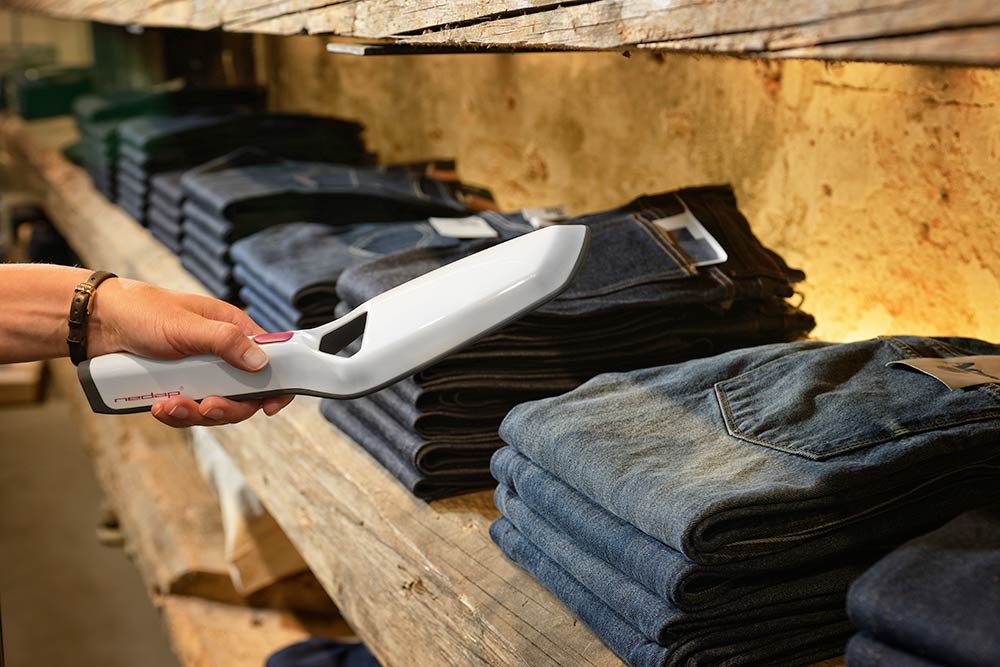Why RFID is revolutionising retail?

RFID is one of the biggest innovations the retail landscape has enjoyed over the past 15 years, but this little acronym stands for a whole lot more than just radio frequency identification. Its constant evolvement and refinement is not only revolutionising product security but changing the playing field of inventory and data management beyond recognition. Here’s the lowdown on RFID tags and what this nifty technology can now do…
What is RFID?
Radio Frequency Identification involves small chips that can collect and store data. The technology is utilised for a variety of purposes including animal micro chipping, passports, and the tracking of cars during the manufacturing process.
In retail it’s used in conjunction with apparel or product tagging, providing insight into stock levels, relaying when an item is picked up and put back and adding limitless potential to enhance the customer’s in-store experience.
RFID tags have readers to decipher the information they contain, but unlike barcodes an RFID tag can be recognised from a distance or even when embedded in an object, allowing for greater accuracy in stock monitoring and security.
An IDTechEx report found that in 2015, the total RFID market was worth $10.1 billion, but was expected to rise to $13.2 billion in 2020. They further noted that in retail the adoption of RFID for product tagging would reach 4.6 billion RFID labels last year – equating to 15% of the total addressable market for apparel .
Security
RFID has traditionally been used for security purposes, alerting a store when an item is being removed from the premises. Using soft or hard tags that can be embedded in products or attached to items, that function continues, but the data stored within RFID and its application has grown significantly over recent years.
Inventory
One of the primary purposes RFID now serves is inventory management. Solutions such as Vitag’s RFID offer an option that counts stock, minimising staff time and costs required to account for inventory.
The tags can either automatically count stock at any given time, relaying levels to a reader and POS system, or be utilised during annual stocktake.
Figures indicated in Forbes notes RFID increases inventory accuracy from an average of 65% to more than 95%. This allows the retailer to not only know what they have on hand at any given moment in real time, but can also automatically alert management when stock runs low, and can even re-order independently when necessary.
The time savings and increased accuracy have seen a massive take-up of the technology with big retailers pushing the trend. Forbes states that by the end of 2017 Macy’s will have rolled out RFID tags across 100% of their stock.
“After expanding RFID to its fashion departments, the department store’s sales volume surged more than 200%, according to a presentation by Melanie Nuce, vice president of apparel and general merchandise for GS1 US, the standards organization, at the Internet of Retail conference last month in New York.
“RFID is a massive time saver for retailers and drives inventory accuracy.” she said.
At a supply level, it’s also being used to notify retailers where stock is and how soon it may arrive, and can track items moving between stores.
Customer experience
While security and increased stock accuracy may be driving the trend, it’s the emerging potential of RFID to hone a customer’s in-store experience that is providing the most exciting and innovative results.
The technology allows for increased speed at the checkout with quick scanning or self service, and works to minimise customer walkouts by ensuring the item they seek is available.
Meanwhile, it’s also being applied beyond the shop floor through interactive change rooms which tell a customer whether an item in a different colour is in stock or via virtual reality and smart mirrors to show a customer what they could look like wearing a different shade or similar style. It’s also being utilised to educate consumers about the items they are interested in.